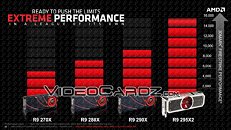- Joined
- Oct 9, 2007
- Messages
- 47,291 (7.53/day)
- Location
- Hyderabad, India
| System Name | RBMK-1000 |
|---|---|
| Processor | AMD Ryzen 7 5700G |
| Motherboard | ASUS ROG Strix B450-E Gaming |
| Cooling | DeepCool Gammax L240 V2 |
| Memory | 2x 8GB G.Skill Sniper X |
| Video Card(s) | Palit GeForce RTX 2080 SUPER GameRock |
| Storage | Western Digital Black NVMe 512GB |
| Display(s) | BenQ 1440p 60 Hz 27-inch |
| Case | Corsair Carbide 100R |
| Audio Device(s) | ASUS SupremeFX S1220A |
| Power Supply | Cooler Master MWE Gold 650W |
| Mouse | ASUS ROG Strix Impact |
| Keyboard | Gamdias Hermes E2 |
| Software | Windows 11 Pro |
Here are some of the key slides from AMD's press-deck (presentation) for reviewers, for the Radeon R9 295X2 dual-GPU graphics card, ahead of its April 8 launch. The slides confirm specifications that surfaced earlier this week, which describe the card as bearing the codename "Vesuvius," having two 28 nm "Hawaii" GPUs, and all 2,816 stream processors on the chips being enabled, next to 176 TMUs, 64 ROPs, and 512-bit wide GDDR5 memory interfaces. Two such chips are wired to a PLX PEX8747 PCI-Express 3.0 x48 bridge chip. There's a total of 8 GB of memory on board, 4 GB per GPU. Lastly, clock speeds are revealed. The GPUs are clocked as high as 1018 MHz, and memory at 5.00 GHz (GDDR5-effective). The total memory bandwidth of the card is hence 640 GB/s.
The Radeon R9 295X2 indeed looks like the card which was pictured earlier this week, by members of the ChipHell tech community. It features an air+liquid hybrid cooling solution, much like the ROG ARES II by ASUS. The cooling solution is co-developed by AMD and Asetek. It features a couple of pump-blocks cooling the GPUs, which are plumbed with a common coolant channel running through a single 120 mm radiator+reservoir unit. A 120 mm fan is included. A centrally located fan on the card ventilates heatsinks that cool the VRM, memory, and the PCIe bridge chip.




The card draws power from two 8-pin PCIe power connectors, and appears to use a 12-phase VRM to condition power. The VRM appears to consist of CPL-made chokes, and DirectFETs by International Rectifier. Display outputs include four mini-DisplayPort 1.2, and a dual-link DVI (digital only). The total board power of the card is rated at 500W, and so AMD is obviously over-drawing power from each of the two 8-pin power connectors. You may require PSUs with strong +12V rails driving them. Looking at these numbers, we'd recommend at least an 800W PSU for a single-card system, ideally with a single +12V rail design. The card is 30.7 cm long, and its coolant tubes shoot out from its top. AMD expects the R9 295X2 to be at least 60 percent faster than the R9 290X at 3DMark FireStrike (performance).





View at TechPowerUp Main Site
The Radeon R9 295X2 indeed looks like the card which was pictured earlier this week, by members of the ChipHell tech community. It features an air+liquid hybrid cooling solution, much like the ROG ARES II by ASUS. The cooling solution is co-developed by AMD and Asetek. It features a couple of pump-blocks cooling the GPUs, which are plumbed with a common coolant channel running through a single 120 mm radiator+reservoir unit. A 120 mm fan is included. A centrally located fan on the card ventilates heatsinks that cool the VRM, memory, and the PCIe bridge chip.




The card draws power from two 8-pin PCIe power connectors, and appears to use a 12-phase VRM to condition power. The VRM appears to consist of CPL-made chokes, and DirectFETs by International Rectifier. Display outputs include four mini-DisplayPort 1.2, and a dual-link DVI (digital only). The total board power of the card is rated at 500W, and so AMD is obviously over-drawing power from each of the two 8-pin power connectors. You may require PSUs with strong +12V rails driving them. Looking at these numbers, we'd recommend at least an 800W PSU for a single-card system, ideally with a single +12V rail design. The card is 30.7 cm long, and its coolant tubes shoot out from its top. AMD expects the R9 295X2 to be at least 60 percent faster than the R9 290X at 3DMark FireStrike (performance).





View at TechPowerUp Main Site
Last edited:









